特蕾莎修女PPT课件
- 格式:ppt
- 大小:1.68 MB
- 文档页数:20
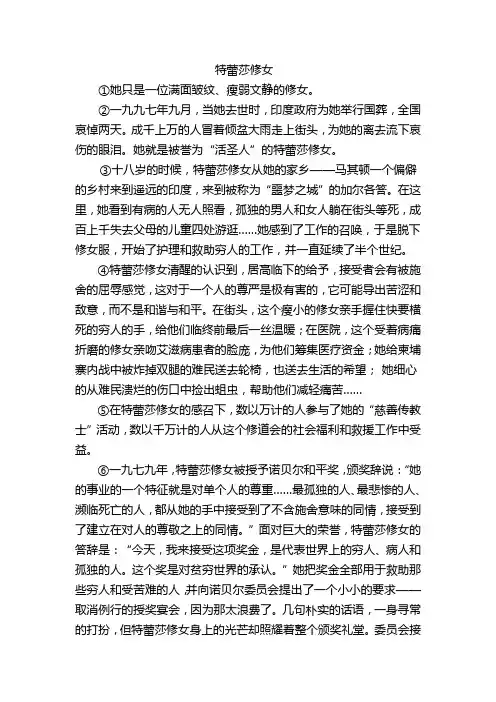
特蕾莎修女①她只是一位满面皱纹、瘦弱文静的修女。
②一九九七年九月,当她去世时,印度政府为她举行国葬,全国哀悼两天。
成千上万的人冒着倾盆大雨走上街头,为她的离去流下哀伤的眼泪。
她就是被誉为“活圣人”的特蕾莎修女。
③十八岁的时候,特蕾莎修女从她的家乡——马其顿一个偏僻的乡村来到遥远的印度,来到被称为“噩梦之城”的加尔各答。
在这里,她看到有病的人无人照看,孤独的男人和女人躺在街头等死,成百上千失去父母的儿童四处游逛……她感到了工作的召唤,于是脱下修女服,开始了护理和救助穷人的工作,并一直延续了半个世纪。
④特蕾莎修女清醒的认识到,居高临下的给予,接受者会有被施舍的屈辱感觉,这对于一个人的尊严是极有害的,它可能导出苦涩和敌意,而不是和谐与和平。
在街头,这个瘦小的修女亲手握住快要横死的穷人的手,给他们临终前最后一丝温暖;在医院,这个受着病痛折磨的修女亲吻艾滋病患者的脸庞,为他们筹集医疗资金;她给柬埔寨内战中被炸掉双腿的难民送去轮椅,也送去生活的希望;她细心的从难民溃烂的伤口中捡出蛆虫,帮助他们减轻痛苦……⑤在特蕾莎修女的感召下,数以万计的人参与了她的“慈善传教士”活动,数以千万计的人从这个修道会的社会福利和救援工作中受益。
⑥一九七九年,特蕾莎修女被授予诺贝尔和平奖,颁奖辞说:“她的事业的一个特征就是对单个人的尊重……最孤独的人、最悲惨的人、濒临死亡的人,都从她的手中接受到了不含施舍意味的同情,接受到了建立在对人的尊敬之上的同情。
”面对巨大的荣誉,特蕾莎修女的答辞是:“今天,我来接受这项奖金,是代表世界上的穷人、病人和孤独的人。
这个奖是对贫穷世界的承认。
”她把奖金全部用于救助那些穷人和受苦难的人,并向诺贝尔委员会提出了一个小小的要求——取消例行的授奖宴会,因为那太浪费了。
几句朴实的话语,一身寻常的打扮,但特蕾莎修女身上的光芒却照耀着整个颁奖礼堂。
委员会接受了这一请求,并且将省下来的七千一百美元赠与她领导的仁爱修会。
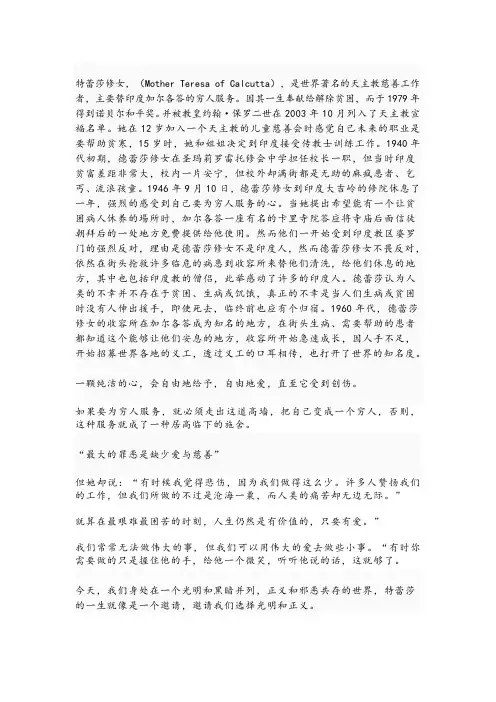
特蕾莎修女,(Mother Teresa of Calcutta),是世界著名的天主教慈善工作者,主要替印度加尔各答的穷人服务。
因其一生奉献给解除贫困,而于1979年得到诺贝尔和平奖。
并被教皇约翰·保罗二世在2003年10月列入了天主教宣福名单。
她在12岁加入一个天主教的儿童慈善会时感觉自己未来的职业是要帮助贫寒,15岁时,她和姐姐决定到印度接受传教士训练工作。
1940年代初期,德蕾莎修女在圣玛莉罗雷托修会中学担任校长一职,但当时印度贫富差距非常大,校内一片安宁,但校外却满街都是无助的麻疯患者、乞丐、流浪孩童。
1946年9月10日,德蕾莎修女到印度大吉岭的修院休息了一年,强烈的感受到自己要为穷人服务的心。
当她提出希望能有一个让贫困病人休养的埸所时,加尔各答一座有名的卡里寺院答应将寺庙后面信徒朝拜后的一处地方免费提供给他使用。
然而他们一开始受到印度教区婆罗门的强烈反对,理由是德蕾莎修女不是印度人,然而德蕾莎修女不畏反对,依然在街头抢救许多临危的病患到收容所来替他们清洗,给他们休息的地方,其中也包括印度教的僧侣,此举感动了许多的印度人。
德蕾莎认为人类的不幸并不存在于贫困、生病或饥饿,真正的不幸是当人们生病或贫困时没有人伸出援手,即使死去,临终前也应有个归宿。
1960年代,德蕾莎修女的收容所在加尔各答成为知名的地方,在街头生病、需要帮助的患者都知道这个能够让他们安息的地方,收容所开始急速成长,因人手不足,开始招募世界各地的义工,透过义工的口耳相传,也打开了世界的知名度。
一颗纯洁的心,会自由地给予,自由地爱,直至它受到创伤。
如果要为穷人服务,就必须走出这道高墙,把自己变成一个穷人,否则,这种服务就成了一种居高临下的施舍。
“最大的罪恶是缺少爱与慈善”但她却说:“有时候我觉得悲伤,因为我们做得这么少。
许多人赞扬我们的工作,但我们所做的不过是沧海一粟,而人类的痛苦却无边无际。
”就算在最艰难最困苦的时刻,人生仍然是有价值的,只要有爱。
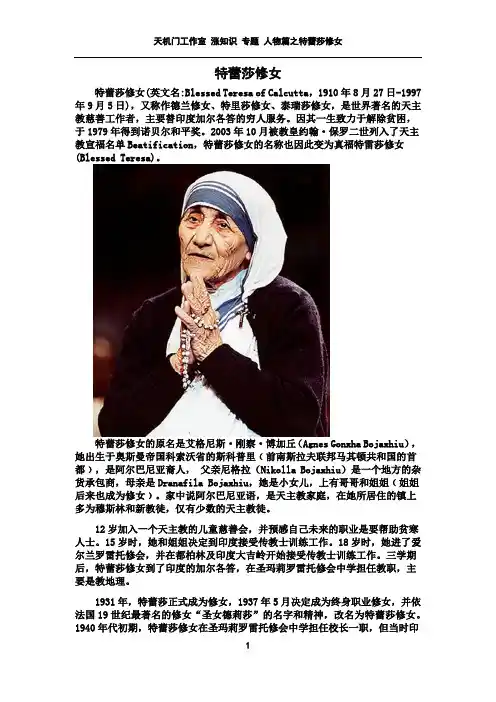
特蕾莎修女特蕾莎修女(英文名:Blessed Teresa of Calcutta,1910年8月27日-1997年9月5日),又称作德兰修女、特里莎修女、泰瑞莎修女,是世界著名的天主教慈善工作者,主要替印度加尔各答的穷人服务。
因其一生致力于解除贫困,于1979年得到诺贝尔和平奖。
2003年10月被教皇约翰·保罗二世列入了天主教宣福名单Beatification,特蕾莎修女的名称也因此变为真福特雷莎修女(Blessed Teresa)。
特蕾莎修女的原名是艾格尼斯·刚察·博加丘(Agnes Gonxha Bojaxhiu),她出生于奥斯曼帝国科索沃省的斯科普里﹙前南斯拉夫联邦马其顿共和国的首都﹚,是阿尔巴尼亚裔人,父亲尼格拉(Nikolla Bojaxhiu)是一个地方的杂货承包商,母亲是Dranafila Bojaxhiu,她是小女儿,上有哥哥和姐姐﹙姐姐后来也成为修女﹚。
家中说阿尔巴尼亚语,是天主教家庭,在她所居住的镇上多为穆斯林和新教徒,仅有少数的天主教徒。
12岁加入一个天主教的儿童慈善会,并预感自己未来的职业是要帮助贫寒人士。
15岁时,她和姐姐决定到印度接受传教士训练工作。
18岁时,她进了爱尔兰罗雷托修会,并在都柏林及印度大吉岭开始接受传教士训练工作。
三学期后,特蕾莎修女到了印度的加尔各答,在圣玛莉罗雷托修会中学担任教职,主要是教地理。
1931年,特蕾莎正式成为修女,1937年5月决定成为终身职业修女,并依法国19世纪最著名的修女“圣女德莉莎”的名字和精神,改名为特蕾莎修女。
1940年代初期,特蕾莎修女在圣玛莉罗雷托修会中学担任校长一职,但当时印度贫富差距非常大,校内一片安宁,但校外却满街都是无助的麻风患者、乞丐、流浪孩童。
1946年9月10日,特蕾莎修女到印度大吉岭的修院休息了一年,并强烈的感受到了自己要为穷人服务的心,返回加尔各答后,她向当地的总主教请求离开学校和修会,但一直得不到许可。

慈善工作者特蕾莎修女特蕾莎修女(Mother Teresa)原名艾格妮丝·刚察·博加丘(Agnes Gonxha Bojaxhiu,1910—1997),是世界著名的天主教慈善工作者,主要替印度加尔各答的穷人服务。
因其一生奉献给解除贫困,而于1979年得到诺贝尔和平奖,并被教皇约翰·保罗二世在2003年10月列入了天主教宣福名单。
目前特蕾莎修女的名称也变为真福特蕾莎修女(Blessed Teresa)。
2009年10月4日,诺贝尔基金会评选“1979年和平奖得主特蕾莎修女”为诺贝尔奖百余年历史上最受尊崇的三位获奖者之一。
12岁时,特蕾莎加入了一个天主教的儿童教会;15岁时,在印度接受传教士的训练工作;18岁时,先是在一位耶稣会修道士的辅助下,加入爱尔兰修道会,这使她有机会跨越欧洲,从马其顿来到都柏林,接受为期一年的训练。
结业后,特蕾莎被派到印度加尔各答圣玛利亚修道院的学校教书。
她在那里讲授地理和历史课长达17年之久,最后成为学校校长。
她以前不叫特蕾莎,而是叫艾格妮丝。
按照教规,成为终身侍奉天主的修女需要经过两次发誓。
1931年,在她21岁的时候,她第一次发誓时,就为自己取了这个教名“特蕾莎”,以此纪念被称为传教圣女的法国加尔默罗会修女圣·特蕾莎。
在圣玛利亚修道院所在地加尔各答,一堵高墙隔绝开了两个世界。
里面的世界充满蜡烛、鸽子、赞美诗、安宁与祥和,外面的世界则是遍布贫穷、饥饿、疾病和痛苦,那些瘦骨嶙峋、皮肤黝黑、衣不蔽体、臭气熏人的乞丐、孤儿、老弱、病人和穷汉缩在角落,那些行将就木的病人身体发臭,身上布满蛆虫。
当这位在女子学校和修院高墙内过着优雅的欧式生活的欧洲女子第一次走到那个凄惨破败、可怕肮脏的世界中,看到那些乞丐、孤儿、老弱、病人和穷汉,她的伟大命运就开始转折了。
她在决定做这件事之前,一直过着好日子,那是一种悠闲、优雅的欧式生活。
在欧洲,以教士和修女为职业的人们从来不愁生计问题,她们有一个庞大而稳固的组织,这个组织有着良好而丰厚的福利制度,在教会这双温暖而安全的羽翼下,她们可以自由成长,做自己喜欢的事情。

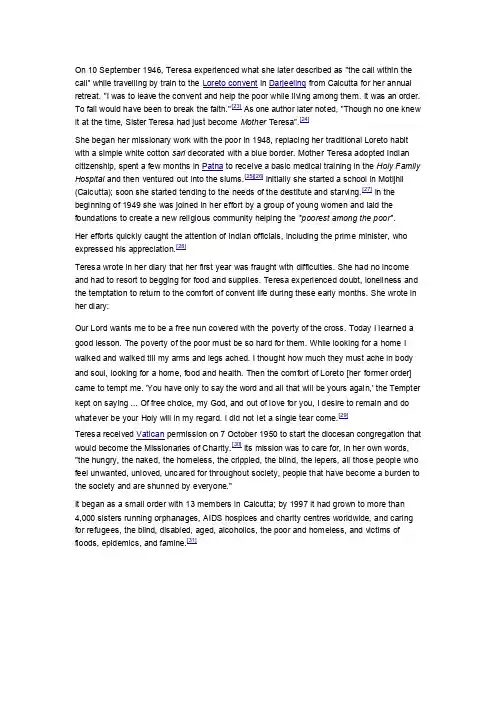
On 10 September 1946, Teresa experienced what she later described as "the call within the call" while travelling by train to the Loreto convent in Darjeeling from Calcutta for her annual retreat. "I was to leave the convent and help the poor while living among them. It was an order. To fail would have been to break the faith."[23] As one author later noted, "Though no one knew it at the time, Sister Teresa had just become Mother Teresa".[24]She began her missionary work with the poor in 1948, replacing her traditional Loreto habit with a simple white cotton sari decorated with a blue border. Mother Teresa adopted Indian citizenship, spent a few months in Patna to receive a basic medical training in the Holy Family Hospital and then ventured out into the slums.[25][26] Initially she started a school in Motijhil (Calcutta); soon she started tending to the needs of the destitute and starving.[27] In the beginning of 1949 she was joined in her effort by a group of young women and laid the foundations to create a new religious community helping the "poorest among the poor".Her efforts quickly caught the attention of Indian officials, including the prime minister, who expressed his appreciation.[28]Teresa wrote in her diary that her first year was fraught with difficulties. She had no income and had to resort to begging for food and supplies. Teresa experienced doubt, loneliness and the temptation to return to the comfort of convent life during these early months. She wrote in her diary:Our Lord wants me to be a free nun covered with the poverty of the cross. Today I learned a good lesson. The poverty of the poor must be so hard for them. While looking for a home I walked and walked till my arms and legs ached. I thought how much they must ache in body and soul, looking for a home, food and health. Then the comfort of Loreto [her former order] came to tempt me. 'You have only to say the word and all that will be yours again,' the Tempter kept on saying ... Of free choice, my God, and out of love for you, I desire to remain and do whatever be your Holy will in my regard. I did not let a single tear come.[29]Teresa received Vatican permission on 7 October 1950 to start the diocesan congregation that would become the Missionaries of Charity.[30] Its mission was to care for, in her own words, "the hungry, the naked, the homeless, the crippled, the blind, the lepers, all thos e people who feel unwanted, unloved, uncared for throughout society, people that have become a burden to the society and are shunned by everyone."It began as a small order with 13 members in Calcutta; by 1997 it had grown to more than4,000 sisters running orphanages, AIDS hospices and charity centres worldwide, and caring for refugees, the blind, disabled, aged, alcoholics, the poor and homeless, and victims of floods, epidemics, and famine.[31]2005 Image of Mother Teresa's Home for the Dying, Nirmal Hriday, in Kolkata.In 1952 Mother Teresa opened the first Home for the Dying in space made available by the city of Calcutta (Kolkata). With the help of Indian officials she converted anabandoned Hindu temple into the Kalighat Home for the Dying, a free hospice for the poor. She renamed it Kalighat, the Home of the Pure Heart (NirmalHriday).[32] Those brought to the home received medical attention and were afforded the opportunity to die with dignity, according to the rituals of their faith; Muslims were read the Quran, Hindus received water from the Ganges, and Catholics received the Last Rites.[33] "A beautiful death," she said, "is for people who lived like animals to die like angels—loved and wanted."[33]Mother Teresa soon opened a home for those suffering from Hansen's disease, commonly known as leprosy, and called the hospice Shanti Nagar (City of Peace).[34] The Missionaries of Charity also established several leprosy outreach clinics throughout Calcutta, providing medication, bandages and food.[35]As the Missionaries of Charity took in increasing numbers of lost children, Mother Teresa felt the need to create a home for them. In 1955 she opened the NirmalaShishuBhavan, the Children's Home of the Immaculate Heart, as a haven for orphans and homeless youth.[36]The congregation soon began to attract both recruits and charitable donations, and by the 1960s had opened hospices, orphanages and leper houses all over India. Mother Teresa then expanded the order throughout the globe. Its first house outside India opened in Venezuela in 1965 with five sisters.[37] Others followed in Rome, Tanzania, and Austria in 1968; during the 1970s the order opened houses and foundations in dozens of countries in Asia, Africa, Europe and the United States.[38]The Missionaries of Charity Brothers was founded in 1963, and a contemplative branch of the Sisters followed in 1976. Lay Catholics and non-Catholics were enrolled in the Co-Workers of Mother Teresa, the Sick and Suffering Co-Workers, and the Lay Missionaries of Charity. In answer to the requests of many priests, in 1981 Mother Teresa also began the Corpus Christi Movement for Priests,[39] and in 1984 founded with Fr. Joseph Langford the Missionaries of Charity Fathers[40] to combine the vocational aims of the Missionaries of Charity with the resources of the ministerial priesthood. By 2007 the Missionaries of Charity numbered approximately 450 brothers and 5,000 sisters worldwide, operating 600 missions, schools and shelters in 120 countries.[41]。
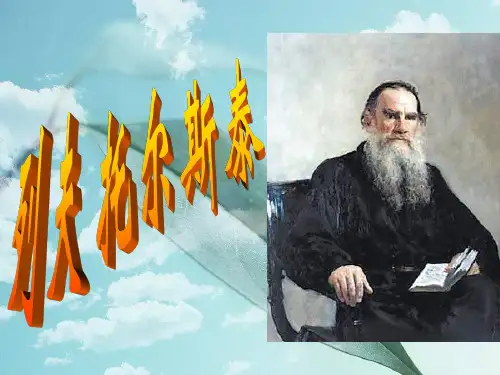
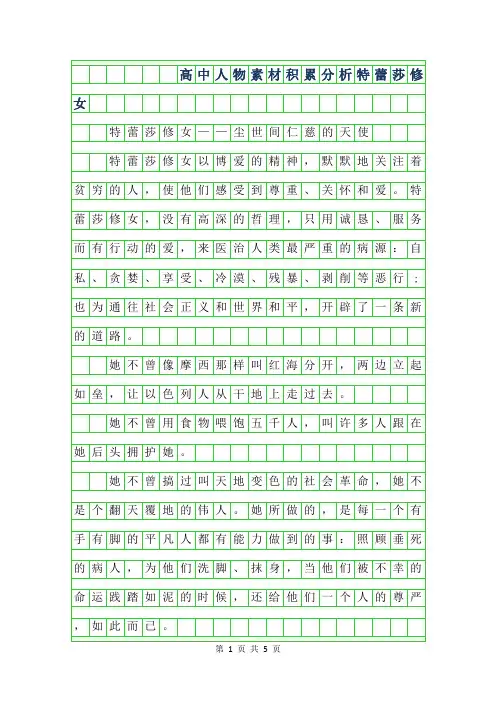


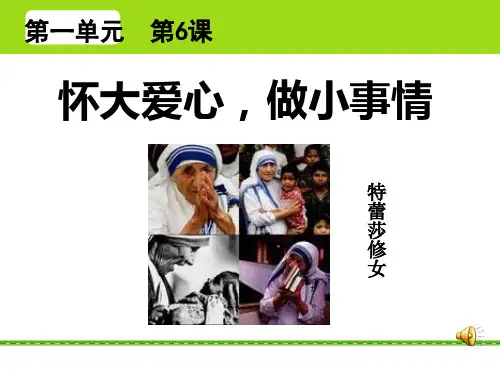
特蕾莎修女1985年在美国的青少年中作了一个调查: 你最崇拜的人是谁?他们共选出九位,六位歌星,一位总统,一位教皇,还有一位就是特蕾莎修女。
•特蕾莎修女于1910年出生在塞尔维亚,本名阿格尼丝。
她的家庭很富有,家中连特蕾莎共有三个孩子。
她小小年纪就开始思索人生,12岁时感悟到自己的天职是帮助穷人,1928年,她来到印度大吉岭工作,担任当地学校的老师,教授地理及历史。
大吉岭位于喜马拉雅山与加尔各答的山脚下。
•1937年,特蕾莎完成了修会的训练,正式宣誓成为修女,并被指派到隶属加尔各答的圣玛丽亚女校中担任校长。
在加尔各答圣玛丽亚女校的墙外却布满了脏乱、污秽的贫民窟。
特蕾莎看见这贫民窟与贵族学校的对比,她心中深受责备。
她知道,贫民窟才是她要去的地方。
她要进入最穷苦、最低贱的人群当中。
1979年,特蕾莎修女获得诺贝尔和平奖.她穿着一件只值一美元的印度纱丽走上领奖台,不管是和总统会见还是服侍穷人,她都穿着这件衣服,她没有别的衣服.台下坐着珠光宝气身份显赫的贵人,她视而不见,她的眼中只有穷人。
•台下立即鸦雀无声:“这个荣誉,我个人不配,我是代表世界上所有的穷人、病人和孤独的人来领奖的,因为我相信,你们愿意借着颁奖给我,而承认穷人也有尊严.”以穷人的名义领奖,是因为她一生都以穷人的名义活着。
当她知道颁奖大会的宴席要花7000美金时,她恳求主席取消宴席,她说你们用这些钱只宴请135人,而这笔钱够15000人吃一天的.宴会被取消了,修女拿到了这笔钱,同时拿到的,还有被她这句话感动之后的40万瑞币捐款.•那个被所有人仰慕的诺贝尔奖牌也被她卖掉了,所得连同奖金全部献给了穷人.对她来说,那些奖牌如果不变成钱为穷人服务,就一钱不值.有一次在飞机上,她发现飞机上的盒饭很多几乎没有吃就拿走扔掉,她立即要求都给她,多少穷人还是垃圾堆里找剩饭吃呢.从此,几个大机场的剩馀盒饭每天都送到印度特蕾莎修女的机构。
•她创建的仁爱传教修女会有四亿多美金的资产,全世界最有钱的公司都争相给她捐款.但是她一生却坚守贫困,她住的地方,只有两样电器,一个是电灯,一个是电话.她的全部财产是一个耶稣像,三套衣服,一双凉鞋,她从来不穿袜子。
特蕾莎修女《美丽的微笑与爱心》作者介绍: 特蕾莎修女(Mother Teresa,1910-1997),印度著名的慈善家,印度天主教仁爱传教会创始人,在世界范围内建立了一个庞大的慈善机构网,赢得了国际社会的广泛尊敬。
1979年被授予诺贝尔和平奖。
本文所选即好在领取该奖项时的演讲辞,语言简洁质朴而感人至深。
诺贝尔奖领奖台上响起的声音往往都是文采飞扬、热烈、激昂。
而特雷莎修女的演说朴实无华,其所举事例听来似平凡之至,然而其中所蕴含的伟大而神圣的爱感人至深。
平凡中孕育伟大,真情才能动人。
我们作文时,要善于从自己所熟知的平凡中发掘伟大,以真情来打动读者。
The poor are very wonderful people. One evening we went out and we picked up four people from the street. And one of them was in a most terrible condition,and I told the sisters: You take care of the other three. I take care of this one who looked worse. So I did for her all that my love can do. I put her in bed, and there was such a beautiful smile on her face. She took hold of my hand as she said just the words "thank you" and she died. I could not help but examine my conscience[良心]before her and I asked what would I say if I was in her place. And my answer was very simple.I would have tried to draw a little attention to myself. I would have said I am hungry, that I am dying, I am cold, I am in pain, or something, but she gave me much more-she gave me her grateful love. And she died with a smile on her face. As did that man whom we picked up from the drain[阴沟、下水道], half eaten with worms, and we brought him to the home. "I have lived like an animal in the street, but I am going to die like an angel, loved and cared for." And it was so wonderful to see the greatness of that man who could speak like that, who could die like that without blaming anybody, without cursing anybody, without comparing anything. Like an angel-this is the greatness of our people. And that is why we believe what Jesus had said: I was hungry, I was naked, I was homeless, I was unwanted, unloved, uncared for, and you did it to me.穷人是非常了不起的人。